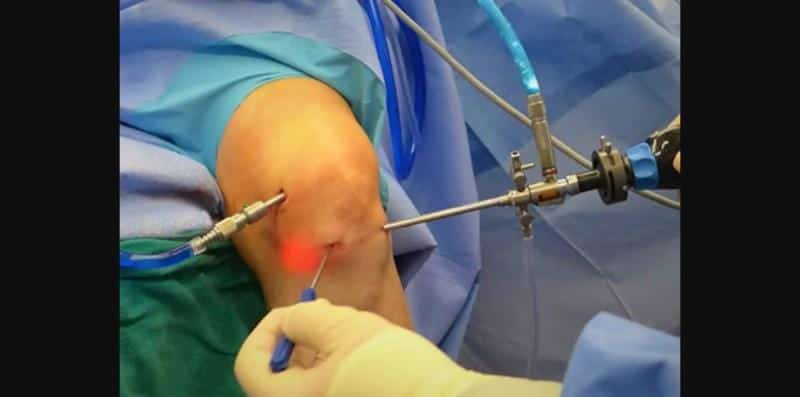Knee Arthroscopy - All About This Surgical Procedure
Knee Arthroscopy - All About This Surgical Procedure

Knee arthroscopy is a surgical procedure that allows doctors to view the knee joint without making a large incision (cut) through the skin and other soft tissues. Arthroscopy is used to diagnose and treat a wide range of knee problems.
During knee arthroscopy, your surgeon inserts a small camera, called an arthroscope, into your knee joint. The camera displays pictures on a video monitor, and your surgeon uses these images to guide miniature surgical instruments.
Because the arthroscope and surgical instruments are thin, your surgeon can use very small incisions, rather than the larger incision needed for open surgery. This results in less pain and joint stiffness for patients, and often shortens the time it takes to recover and return to favorite activities.
Arthroscopic surgery
During arthroscopy, your surgeon can see the inside of your knee in great detail on a video monitor.
Anatomy
Your knee is the largest joint in your body and one of the most complex. The bones that make up the knee include the lower end of the femur (thighbone), the upper end of the tibia (shinbone), and the patella (kneecap).
Other important structures that make up the knee joint include:
- Articular cartilage. The ends of the femur and tibia, and the back of the patella are covered with articular cartilage. This slippery substance helps your knee bones glide smoothly across each other as you bend or straighten your leg.
- Synovium. The knee joint is surrounded by a thin lining called synovium. This lining releases a fluid that lubricates the cartilage and reduces friction during movement.
- Meniscus. Two wedge-shaped pieces of meniscal cartilage between the femur and tibia act as shock absorbers. Different from articular cartilage, the meniscus is tough and rubbery to help cushion and stabilize the joint.
- Ligaments. Bones are connected to other bones by ligaments. The four main ligaments in your knee act like strong ropes to hold the bones together and keep your knee stable.
- The two collateral ligaments are found on either side of your knee.
- The two cruciate ligaments are found inside your knee joint. They cross each other to form an X with the anterior cruciate ligament in front and the posterior cruciate ligament in back.

When Knee Arthroscopy is Recommended
Your doctor may recommend knee arthroscopy if you have a painful condition that does not respond to nonsurgical treatment. Nonsurgical treatment includes rest, physical therapy, and medications or injections that can reduce inflammation.
Knee arthroscopy may relieve painful symptoms of many problems that damage the cartilage surfaces and other soft tissues surrounding the joint.
Common arthroscopic procedures for the knee include:
- Partial meniscectomy (removal of the meniscus), repair of a torn meniscus, or meniscus transplantation
- Reconstruction of a torn anterior cruciate ligament or posterior cruciate ligament
- Removal of inflamed synovial tissue
- Trimming or reconstruction of damaged articular cartilage
- Removal of loose fragments of bone or cartilage, like those caused by synovial chondromatosis
- Treatment of patella (kneecap) problems
- Treatment of knee sepsis (infection)
What to Expect After a Knee Arthroscopy?
Knee arthroscopy is a minimally invasive procedure that requires only a short time in the operating room and a brief period in the recovery room. Most patients can go home on the same day, and the entire process usually takes just a few hours from start to finish.
How Long Does an Arthroscopy Take?
Arthroscopic knee surgery is a minor procedure that typically takes between 30 and 45 minutes to complete. Most patients will require general anesthesia during the operation.
Is an Arthroscopy Painful?
Arthroscopic surgery uses small incisions, which means it can get patients back to their normal activities quickly with minimal scarring and pain. Patients can generally expect to return to their normal activities, with some restrictions, within a few days.
How Painful Is Knee Arthroscopy?
Pain is common after knee arthroscopy, usually in the area where patients experienced pain before the procedure, as well as in the soft tissues below the kneecap, above the incisions, and sometimes throughout the entire knee. Pain typically improves within two to three weeks but can take up to six weeks to fully subside.
Other Resources:


